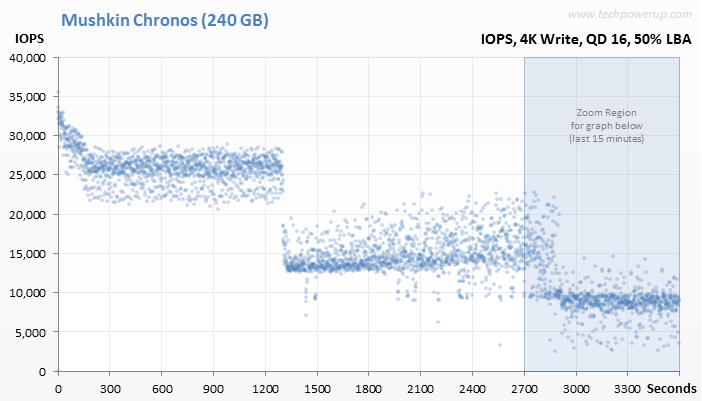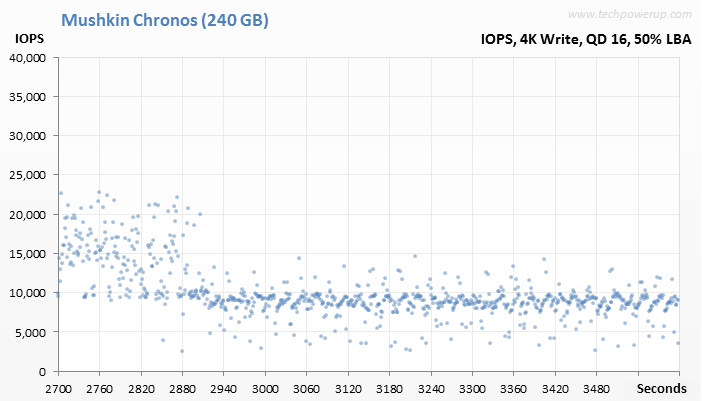 4
4
Mushkin Chronos 240 GB Review
Windows 7 Startup & Software Installation »Steady State Performance
In this test, we put the drive through a steady-state measurement of its write performance in which we write onto the drive with a non-stop, fully-randomized stream of data for an hour (in which the controller can't find patterns).The drive's 4K write performance is measured over three levels of loading (amount of used space vs. amount of free space for the controller to use as a potentially spare performance-enhancing area). The three levels we used are 50%, 75%, and 100% LBA. The test may not be a suitable representation of a consumer scenario in which data is typically written in short bursts with lower QD, but can be of academic interest in showing you how the various SSD controller architectures manage their NAND flash resources.
SSD controllers work in mysterious ways. Some of them also use free NAND flash area as performance-enhancing "scratchpads." Some modern controllers such as the SandForce SF-2281 and LAMD LM87800 have a fixed amount of physical NAND flash - known as the overprovisioned area -allotted to these "scratchpads". The controllers can even use free-space in the user-area (the part of the SSD's NAND flash that isn't overprovisioned). As we begin our test, the SSD controller has vast amounts of free space / OP area at its disposal, which causes it to pump out its highest write IOPS. Once the overprovisioned (OP) area is full, we see write IOPS drop like a rock until it plateaus. We still notice the odd spikes as the controller finds free space to use. Towards the end (the last 15 minutes), the SSD controller will have run out of such free space to provide a metric we call "steady state write performance". That phase of our test is of particular importance, and the second graph below focuses on that portion.
| Capacity Used: Compare with: |
 |
 |
Feb 11th, 2025 22:22 EST
change timezone
Latest GPU Drivers
New Forum Posts
- RTX5000 Series Owners Club (86)
- What are you playing? (22864)
- TECHPOWERUP HWBOT Contest Submissions List (66)
- It's happening again, melting 12v high pwr connectors (245)
- Help me decide..........OLED monitors (28)
- 9800X3D OC Limits? (10)
- Do I need to spend extra money on my MOBO? (48)
- USB-C JBOD box (24)
- I dont like my new CPU Cooler (85)
- Daisy chaining mixed 4-pin fans (23)
Popular Reviews
- Civilization VII Performance Benchmark Review - 35 GPUs Tested
- Kingdom Come Deliverance II Performance Benchmark Review - 35 GPUs Tested
- Team Group T-Force XTREEM DDR5-7200 48GB CL34 Review
- ASRock Phantom Gaming B850I Lightning Wi-Fi Review
- DAREU A980 Pro Max Review
- AMD Ryzen 7 9800X3D Review - The Best Gaming Processor
- NVIDIA GeForce RTX 5080 Founders Edition Review
- Corsair Frame 4000D Review
- Spider-Man 2 Performance Benchmark Review - 35 GPUs Tested
- MSI GeForce RTX 5080 Vanguard SOC Review
Controversial News Posts
- AMD Radeon 9070 XT Rumored to Outpace RTX 5070 Ti by Almost 15% (287)
- AMD is Taking Time with Radeon RX 9000 to Optimize Software and FSR 4 (256)
- AMD Denies Radeon RX 9070 XT $899 USD Starting Price Point Rumors (239)
- Edward Snowden Lashes Out at NVIDIA Over GeForce RTX 50 Pricing And Value (239)
- AMD Radeon RX 9070 XT & RX 9070 Custom Models In Stock at European Stores (226)
- New Leak Reveals NVIDIA RTX 5080 Is Slower Than RTX 4090 (215)
- AMD's Radeon RX 9070 Launch Faces Pricing Hurdles (175)
- AMD Radeon RX 9070 XT Tested in Cyberpunk 2077 and Black Myth: Wukong (169)